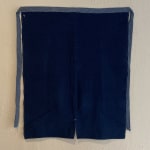-
Artworks



artisan's name unknown
Indigo Apron, late 1800's to early 1900'sCotton30 x 23 1/2 "SoldFurther images
This is a 100-year-old apron. The rich blue color has been retained impeccably over such a long period. It's color aside, the details of this work capture me. A striped...This is a 100-year-old apron. The rich blue color has been retained impeccably over such a long period. It's color aside, the details of this work capture me.
A striped textile of white and blue is used for the waistband. Just below it, on the top left corner, there is a letter which reads "Te," テfor Tedai, stitched with the Sashiko technique. Tedai signified a rank for a member of a merchant business. In ascending order, the ranks were Decchi, Tedai, and Banto. A Tedai was considered a full-fledged member of the company, entrusted to perform general shopkeeping duties. Businesses would employ anywhere from five to thirty Tedai and typically they were provided shelter and payment for their work. After long years of training and devotion, the most exceptional would be promoted to the esteemed position of Banto, essentially the general manager of the store.
There is a small triangular pattern on the seam at the lower middle of the apron. This was also made with the Sashiko technique. In Japanese, Sashiko means "little stitches," referencing a simple running stitch technique that involves regular stitches with precise spacing to create various patterns. It was a technique that arose from practical necessity; it served a decorative function and reinforced points of wear and repair damages. These stitches support the apron segment that tends to rip from getting up and kneeling down on tatami mats hundreds of times a day.
Signup for our Newsletter
You will receive two emails a month from us. One introduces artworks and design works from Kyoto's hidden sources and the other is stories from Misako, sharing insights into Japanese culture.
* denotes required fields
为了回应您的查询,我们将根据我们的隐私政策处理您提供的个人数据。





